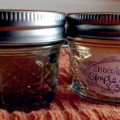This spring, I am on a mission to plant a herb garden. The more I read about herbs, the more fascinated I am about the healing properties of so many ordinary herbs, and about how many ways there are to use culinary herbs as herbal home remedies. First in my new series about herbs: mint as a home remedy.
Mint and Peppermint Herbal Home Remedies
Drink mint tea and peppermint tea to relieve indigestion, flatulence, nausea or hiccups (cold mint tea is best for hiccups) or to stimulate digestion after a heavy meal. Drink several cups of peppermint and mint tea a day during colds and fevers, or to relieve a sore throat. A steam inhalation with Peppermint essential oil relieves nasal congestion during colds or sinus infections.
Peppermint essential oil is an excellent home remedy for headaches too. Dilute 1-2 drops of Peppermint oil into 1 teaspoon of almond oil and massage on the temples (avoid the eyes: it will sting badly), or make a cold compress: dip a small towel into a bowl of water into which you’ve added a drop or two of Peppermint essential oil. Squeeze out the excess water and place the compress on your forehead. Don’t use Peppermint essential oil at night, though, as it can keep you awake.
Add a bunch of fresh mint or peppermint into your bath water for a refreshing bath or to relieve achy muscles. For a less messy bath, fill small muslin bags (like these, or make your own) with fresh mint leaves and add a bag into the bath.
Decorate fruit salads and chocolate desserts with fresh mint leaves, or add flavor to cold drinks with a sprig of fresh mint. And mint even works as a natural insect repellent/pesticide: sprinkle mint leaves in the pantry to keep mice and ants away or use a few drops of Peppermint oil, it does the same trick.
How to Grow Mint at Home
Mint (Mentha) belongs to the Labiatae family and because the different mint species and subspecies cross with each other easily, there are countless different varieties of mint. Keep different types of mints in their own separate areas (or perhaps in separate pots) in the garden to prevent them from spreading and crossing with your other mint varieties. But do grow mint near plants that attract aphids as it seems to keep them away. Mint grows best in half shade or in sun but likes moisture, although it seems to be strong enough to survive in all sorts of conditions.
Sources:
Lesley Bremness: The Complete Book of Herbs (Studio, 1994)
Patricia Davis: Aromatherapy, an A-Z (Random House, UK, 2004)
Photo: Mentha Arvensis by Kristian Peters









